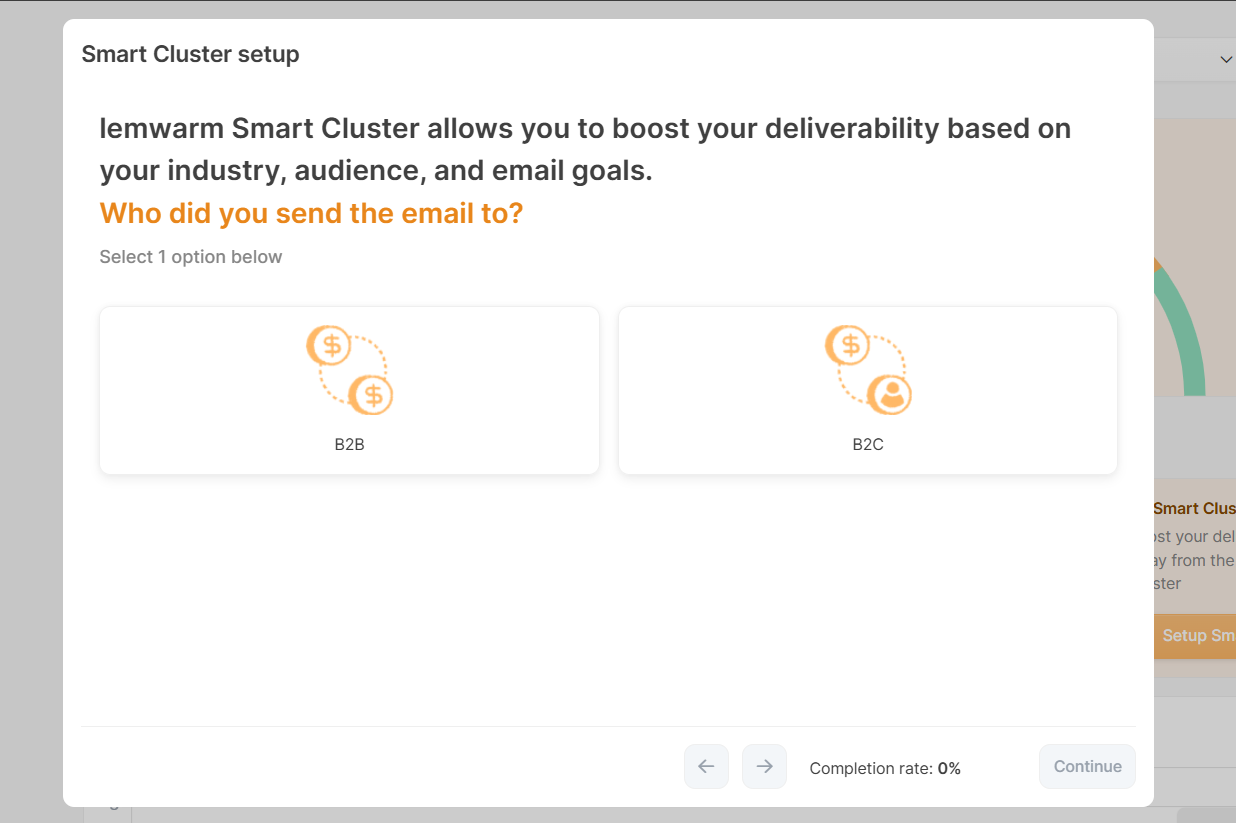Email warm-up is now a non-negotiable for anyone sending cold emails.
These tools can help you safely warm up new accounts or repair old ones that lost their reputation.
But which tool is the best?
To answer this, I tested almost every major warm-up platform available.
- Lemwarm
- Warmy
- Warmup Inbox
- MailReach
You name it, I have tested it.
I have written detailed reviews on each tool, analyzing their real warm-up performance and ease of use.
But this time, I wanted to dig deeper.
I wanted to compare two of the most popular tools side by side to see which one truly delivers better results.
So I decided to start my own series, “The Top Pick”
In this first showdown, I am putting Lemwarm and Warmy against each other.
If you are comparing these tools for your outreach stack,
this breakdown will help you make a smarter choice.
Keep reading to find out which tool wins.
Lemwarm vs Warmy – TOC
Quick Summary of Lemwarm vs Warmy
If you want the short answer, here it is.
Lemwarm and Warmy both help you warm up new and old email accounts to build and fix sender reputation.
The difference is majorly in cost.
- Lemwarm is more affordable than Warmy.io, costing $29 per month per inbox.
- Both deliver similar warm-up results in a 3 to 4-week period for new accounts.
- Results for older accounts depend on the extent of reputation damage.
- Both tools have premium features, but they do not make a big difference in deliverability. The core warm-up process is enough to get your accounts ready for outreach.
- Compared to Lemwarm, Warmy offers more customization features.
- A better alternative to both tools is TrulyInbox. No per inbox pricing, lets you connect multiple accounts under any plan, no fancy features, and delivers the same result.
| Comparision | Lemwarm | Warmy.io | TrulyInbox |
|---|---|---|---|
| Starting Price (Annual Billing) | $24/month/inbox | $29/month/inbox | $22/month |
| Cost of connecting 5 inboxes (monthly pricing) | $145/month (Essential Plan) | $196/month (Starter Plan) | $22/month (Starter Plan) |
| Best For | Small teams and beginners | Users who want deeper customization and are ready to pay | Businesses and agencies that want scalability and cost-effectiveness |
| Scalability | Limited by per inbox pricing | Limited by per inbox pricing | Connect unlimited inboxes under any plan |
| Time Taken to Warm Up New Accounts | 3 to 4 weeks | 3 to 4 weeks | 3 to 4 weeks |
My Detailed Comparison of Lemwarm and Warmy’s Warm-Up Capabilities
Here I will share my detailed experience with both platforms.
To test both platforms, I used 10 brand-new email accounts and a few older accounts that had suffered some reputation damage.
Here is my complete experience with both tools.
- My Experience With Lemwarm
- My Experience With Warmy.io
- Key Differences And Limitations
- Which Platform Helped Me The Most
My Experience With Lemwarm
Lemwarm was the first tool I tested.
I purchased the Essential Plan for 8 inboxes and the Smart Plan for 4 accounts.
I wanted to see if the premium features made any real difference in warm-up results!
For accounts with the base plans, I easily set up my accounts and start the warm-up process.
In the Smart Plan, you can activate the Smart Cluster.

It tailors your warm-up based on your inputs, such as:
- Whether you target B2B or B2C
- The type of emails you send
- The regions your leads live in
- The size of the companies you reach out to
- The industry you target, etc

I then let the warm-up run for 4 weeks.
Here are the results I saw:
- All the new inboxes got an average inbox placement rate of 90%.
This was regardless of whether I used the Essential Plan or the Smart Plan. - The older email accounts recovered to around 72%.
These inboxes had some reputation damage, so this result was expected.
Overall, the warm-up results were satisfactory.
In total, I spent $428/month to warm up these 12 accounts.
Which is quite a lot of money for warm-up.
At this point, I feel like I should get an award for
“Most Money Spent Just to Prove a Point”.
I am saying this because the same setup with TrulyInbox would have cost me only $79/month.

Here is how:
The Growth Plan costs $79/month and allows 1,000 warm-up emails per day.

You can connect anywhere from 6 to 50 accounts under this plan.
(recommended range by TrulyInbox)
This is a huge difference compared to Lemwarm.
And the per inbox cost ranges from $13.2/inbox/month to $1.6/inbox/month.
So the more accounts you connect, the more cost-effective it becomes!
Next, I will share my experience with Warmy.io.
Also Read: 8 Best Lemwarm Alternatives & Competitors in 2025
My Experience With Warmy.io
I wanted to warm up 12 accounts with Warmy.io. That was the plan.
But the moment I checked the price, I paused.
The total cost came to $1,007 per month.

So I took the most logical next step.
I quietly closed the pricing page and pretended I never saw it.
Or that is what any normal person would do.
But I decided to at least test it with 2 accounts and see if the high price came with high performance.
That is when I noticed something else.
If you want the premium features, like:
- selecting your warm up language
- selecting your warm up topic
You need the Premium Plan for that, and it costs $341/month/inbox.

So I got the Starter Plan and connected 2 accounts, spending $89/month.
Again, I connected the inboxes and ran the warm-up for 4 weeks.
- The new inbox reached about 87% inbox placement.
- The older inbox recovered to around 72% inbox placement.
These are the same results I got with Lemwarm.
There was no extra lift in inbox placement, no faster recovery, and no special advantage that justified the higher cost.
Warmy.io worked well, but the performance matched Lemwarm almost exactly.
The only real difference was the price. And that is a tough difference to ignore.
Next, I will share the key differences and limitations I found while testing both tools.
Also Read: Top 8 Warmy.io Alternatives to Improve Email Deliverability in 2025
Key Differences And Limitations
After testing both tools side by side, a few clear differences stood out.
Lemwarm keeps things simple.
It gives you the essential warm-up features and does not overwhelm you with too many settings.
On the other hand, Warmy.io gives you more customization.
You can pick the warm-up language, warm-up topic, and even adjust the warm-up speed.
The major difference for me was the pricing.
- Lemwarm with the base plan will cost you $290/month to warm up 10 email accounts.
- Warmy.io will cost you $903/month (Business Plan) for the same number of accounts.
The results are the same, but the cost gap is too big to ignore.
Which Platform Helped Me The Most
I would definitely say Lemwarm.
Though it was expensive and cost me ~$500 dollars, I was still able to warm up the number of accounts I originally planned.
That wasn’t the case with Warmy.io.
It was just too expensive.
Lemwarm Vs Warmy Pricing
Although by now you would know which tool offers better value, here is a clear breakdown of how both pricing structures actually compare.
Lemwarm Pricing
Lemwarm has 2 paid plans:
- Essential Plan – $29/month/inbox
- Smart Plan – $49/month/inbox
Adding more inboxes does not reduce the cost. You pay the full rate for each one.

Essential Plan gives you the basics:
- SPF, DKIM, DMARC setup check
- Custom tracking domain setup
- Spam Assassin score for your email content
- Human-like warm-up mails
- Warm up from a pool of more than 20k+ healthy domains
- Basic warm-up settings and customization
In the Smart Plan, you get everything in the Essential Plan plus:
- Tailored warm-up based on your inputs through Smart Cluster
- Custom templates for warm up
- Custom alerts
- Warm up based on your industry
Warmy.io Pricing
Warmy.io paid plans are a bit complex compared to Lemwarm.
There are 5 paid plans, and each plan gives you a set number of warm up emails you can send per day.
The cost gets discounted when you connect more inboxes.
But the price is still high even after the discount.
This is the cost to connect 1 email account:

| Plans | Starter | Business | Premium | Expert | Platinum |
|---|---|---|---|---|---|
| Cost | $49/month | $129/month | $189/month | $279/month | $429/month |
| Warm Up Emails/Day | 100 | 300 | 1,000 | 2,000 | 5,000 |
| DNS records test | 5 | 10 | 25 | 50 | 50 |
| Inbox placement test | 5 | 10 | 25 | 50 | 50 |
| Select warm-up language | ❌ | ✅ | ✅ | ✅ | ✅ |
| Select warm-up topic | ❌ | ❌ | ✅ | ✅ | ✅ |
| Google Postmaster Integration | ✅ | ✅ | ✅ | ✅ | ✅ |
This is the cost to connect 5 email accounts:

| Plans | Starter | Business | Premium | Expert | Platinum |
|---|---|---|---|---|---|
| Cost | $196/month | $516/month | $756/month | $1116/month | $1716/month |
| Per Inbox Cost | $39.2/month | $103.2/month | $151.2/month | $223.2/month | $343.2/month |
| Warm Up Emails/Day | 100 | 300 | 1,000 | 2,000 | 5,000 |
| DNS records test | 5 | 10 | $25 | 50 | 50 |
| Inbox placement test | 5 | 10 | 25 | 50 | 50 |
| Select warm-up language | ❌ | ✅ | ✅ | ✅ | ✅ |
| Select warm-up topic | ❌ | ❌ | ✅ | ✅ | ✅ |
| Google Postmaster Integration | ✅ | ✅ | ✅ | ✅ | ✅ |
Final Verdict – Who Wins Lemwarm or Warmy.io?
Between Lemwarm and Warmy.io, Lemwarm is the clear winner.
It gives good results, and the cost is manageable to an extent.
That said, there is an even better option if you are open to looking beyond these two: TrulyInbox.
The main reasons I recommend it are cost and scalability.
You connect unlimited accounts for a fixed price,
which brings the cost per inbox down to a very low level.
So, if budget matters and you want the same warm-up quality, TrulyInbox is the smarter pick.
Sign up for the forever-free plan to test it yourself.
FAQs
1. Which Platform Is Better for Small Businesses: Lemwarm or Warmy?
Compared to Warmy, I would recommend Lemwarm.
Both deliver similar results, but Lemwarm is far more cost-effective, starting at $29/month per inbox, while Warmy is significantly more expensive.
That said, if I could recommend a tool outside these two, I’d go with TrulyInbox.
It is highly scalable, and the per-inbox cost can go as low as $1.6.
2. How Do Lemwarm and Warmy Differ in Terms of Pricing?
Lemwarm has two paid plans and charges per inbox. The pricing starts at $29/month per inbox (Essential Plan).
Warmy.io, on the other hand, has 5 paid plans and also charges per inbox. Each plan allows you to send a set limit of warm-up emails per day.
For example, in the Starter Plan, you can send 100 warm-up emails per day for $49/month per inbox.
If you connect 2 inboxes, the cost drops to $89/month, or $44.50/inbox.
For three inboxes, it becomes $133/month, which comes to about $44.3/ inbox.
The more inboxes you add, the slightly cheaper it gets, but it still ends up being more expensive than Lemwarm overall.
3. Does Warmy.io and Lemwarm offer a free trial?
Both tools offer a limited free trial.
- Warmy.io gives you a 7-day free trial.
- Lemwarm gives you a 14-day free trial, but you need to sign up through Lemlist since Lemwarm is part of their ecosystem.
4. Which Platform Offers Better Customization for Warm-Up Sequences?
In the base plan, both tools offer only basic warm-up controls.
In the higher plans, Warmy gives you more features like language selection, topic selection, and ESP-based warm-up.
Lemwarm offers fewer advanced settings, but still gives useful options such as custom templates and personalization based on your inputs.
That said, in my experience, these extra controls exist mostly to inflate the price.
Their impact on improving sender reputation is very small.
I was able to get the same results with TrulyInbox for a fraction of the cost and without any of these fancy settings.
5. How Long Does It Take to See Results With Lemwarm and Warmy?
Lemwarm says the initial warm up phase takes around 3 to 4 weeks.
Warmy gives you more control to speed it up, but warns that going too fast can hurt deliverability.
When I personally tested Warmy.io, I was able to warm up my new accounts in about 4 weeks with stable results.
6. Is It Worth Upgrading to the Premium Plans for Additional Features?
No, it is not worth upgrading for the extra features.
I got the same results on accounts using only warm up, and on accounts using warm up plus the so-called advanced settings.
The extra controls do not create a meaningful difference in sender reputation, so upgrading just for the features is not necessary.
7. Can I Pause or Stop the Warm-Up Once the Sender Reputation is Established, and What Happens Then?
After you finish the warm up, you can pause it and start your cold email campaigns.
This lets you send more cold emails.
But your sender reputation will get hit faster.
That is why I prefer and recommend keeping your warm-up active at a low level in the background.
It helps maintain your reputation while you scale your outreach safely.
8. Which Tool Would You Recommend for Someone New to Email Warm-Up?
I would recommend beginners to try TrulyInbox.
It is easy to use and set up, and far more affordable than most tools.
Since it supports unlimited accounts for a flat price, it is also the best long-term option if you plan to scale later.



